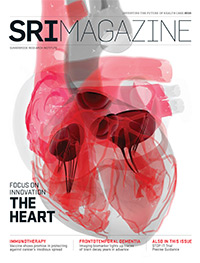More Is Better
Intensive dialysis treatment generally safe for women with kidney failure

Meghan Kilner gave birth to a healthy boy at 37 weeks gestation after months of intensive dialysis. Leeland Allen Kilner Code was born on Jan. 18, 2015 at Sunnybrook.
Photo: Courtesy of Meghan Kilner
Read about Meghan Kilner’s journey through pregnancy and dialysis.
Pregnancy is often impossible in young women with advanced kidney disease. In the rare instances where women on dialysis are able to conceive, pregnancy is associated with complications and can be dangerous for mother and baby.
Dialysis is a blood-cleansing procedure used when kidneys no longer function. It helps to remove toxins from the body. In women of childbearing age who are on dialysis the rate of pregnancy in some studies is less than 1%.
Looking to improve that figure, researchers at Sunnybrook Research Institute (SRI), along with colleagues at Mount Sinai Hospital, the University Health Network and community nephrologists, looked at data from a Toronto nocturnal hemodialysis program that suggested treating women with a more intensive dose of dialysis might restore ovulation cycles, thereby enabling conception, pregnancy and childbirth.
Dr. Michelle Hladunewich, an associate scientist in the Women & Babies Research Program at SRI and director of nephrology and obstetrical medicine at Sunnybrook, led the effort. It was the first retrospective cohort study to compare dialysis outcomes in pregnant women in Canada and the U.S.
The team compared data from a Toronto and an American registry. They looked at the rates of live birth, gestational age and birth weight from 22 pregnancies in the Toronto group and 70 pregnancies in the U.S. cohort.
Pregnant women in Toronto received more aggressive treatment. On average, they received dialysis for 43 hours per week; women in the U.S. cohort received it for 17 hours.
The results, published in the Journal of the American Society of Nephrology, also found a significantly higher live birth rate in the Canadian versus American cohort: 86.4% versus 61.4%. Critically, the researchers found that women on dialysis for more than 36 hours per week had a live birth rate of 85%, compared with 48% in patients who received fewer than 20 hours of dialysis per week.
“Frequent and longer dialysis sessions dramatically improved pregnancy outcomes and should be considered for dialysis patients who want to become pregnant or who are already pregnant,” says Hladunewich, who is also an associate professor at the University of Toronto.
Moreover, intensive dialysis had other benefits. “Not only did we have a higher live birth rate, but these pregnancies lasted longer and the babies were a little bit bigger. That makes a big difference in terms of neonatal intensive care and long-term outcomes for these children,” says Hladunewich. The median duration of pregnancy for Canadian women was 36 weeks, versus 27 weeks for American women.
Although there were a few maternal and neonatal complications, they were manageable; overall, the study showed pregnancy is generally safe and feasible in women who are given more intensive dialysis. “This was an opportunity to say that something we’re doing well here can be replicated elsewhere, so that there is more hope for women who lose their kidney function and hence their fertility during their reproductive ages,” she says.
— Eleni Kanavas




